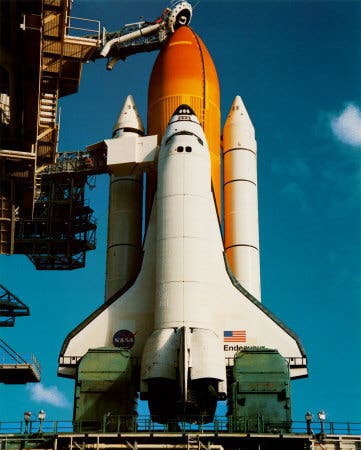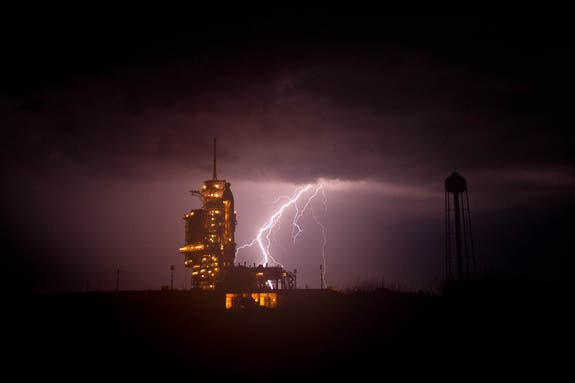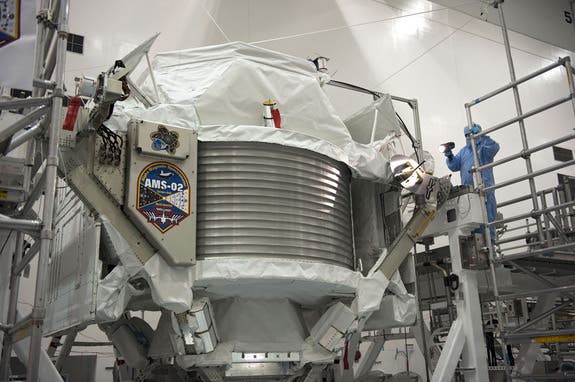As I was telling you a few days ago, after Discovery, Endeavour is also preparing for its last trip, led by space veteran Mark Kelly. The weird thing is that Endeavour, which will be retired after today’s last mission, is at the moment also NASA‘s youngest orbiter, which kind of speaks a lot about NASA’s capacity to modernize its fleet. The thunderstorm that took place last night provided some spectacular photos, but it probably won’t affect the launch in any way.
Endeavour is set for launch today, April 29, at 3:47 p.m. EDT (1947 GMT) from the Kennedy space center, in what seems to be like good weather. However, if clouds or some other meteorological problem is present, the launch will be delayed, but not too much.
The orbiter will travel to the International Space Station (ISS) for a two week visit. Its goal is to deliver a $2 billion astrophysics experiment designed to hunt for exotic subatomic particles.
The shuttle’s whole crew consists of six veterans, including pilot Gregory H. Johnson and mission specialists Michael Fincke, Greg Chamitoff, Andrew Feustel, and European Space Agency astronaut Roberto Vittori, will be led by commander Mark Kelly.
Endeavour’s launch has drawn an impressive amount of public to the site, and all in all 700.000 people are expected to watch the launch – even though it’s scheduled on the same day as the big royal wedding between between Prince William and Kate Middleton in England. President Barack Obama, his wife Michele, and his two daughters will also be present at the launch; it is only the second time in history that a president will be present at a shuttle launch, after Bill Clinton’s visit in 1998.
Another high profile visitor will be Kelly’s wife, wounded Congresswoman Gabrielle Giffords, who was tragically wounded after a failed assasination attempt when a gunman opened fire on her and others outside a Tucson, Ariz., grocery store. This was tragic not only for Kelly, but for the whole crew, who always sticks together:
“The crew has just done a tremendous job of staying on focus and being trained and ready to go fly,” NASA’s associate administrator for space operations, Bill Gerstenmaier, said during a press conference last week. “It’s a testimony to the entire crew’s ability to stay focused, to compartmentalize and to do what they need to do.”
The Alpha Magnetic Spectrometer (the astrophysics experiment I was telling you about) will be installed on the space station with the goal of keeping an eye out for cosmic ray particles that might shed light on cosmic mysteries such as the invisible dark matter which has puzzled researchers for so long.
It’s the premier physics experiment; it’s probably the most expensive thing ever flown by the space shuttle,” Kelly said in a NASA interview.
In addition to the spectrometer, Endeavour will also be carrying 14,000 pounds (6,350 kg) of spare supplies to outfit the space station for the era after the shuttles stop flying. To help install some of the equipment, an ambitious four space walks are scheduled, which will be finished in 14 days, but NASA says they are fine with a few extra days as well. Even if everything goes according to plan, the victory will be bittersweet at best, because this doesn’t only mark the end of Endeavour, but it marks the end of an era.
“We know the end is coming and we’re dealing with it,” shuttle launch director Mike Leinbach said. “The emotional aspect is very, very real and it’s very difficult to put into words, but I think all of Kennedy Space Center got a big boost when we got the word that were going to be able to keep Atlantis.”
After Endeavour’s last flight, NASA plans one more shuttle flight, the June launch of Atlantis, and after that, the space shuttle program will come to an end. That’s it, no more Discovery, no more Endeavour, no more Atlantis; no more space orbiters for NASA. I don’t know about you, but it’s pretty emotional where I’m standing.







